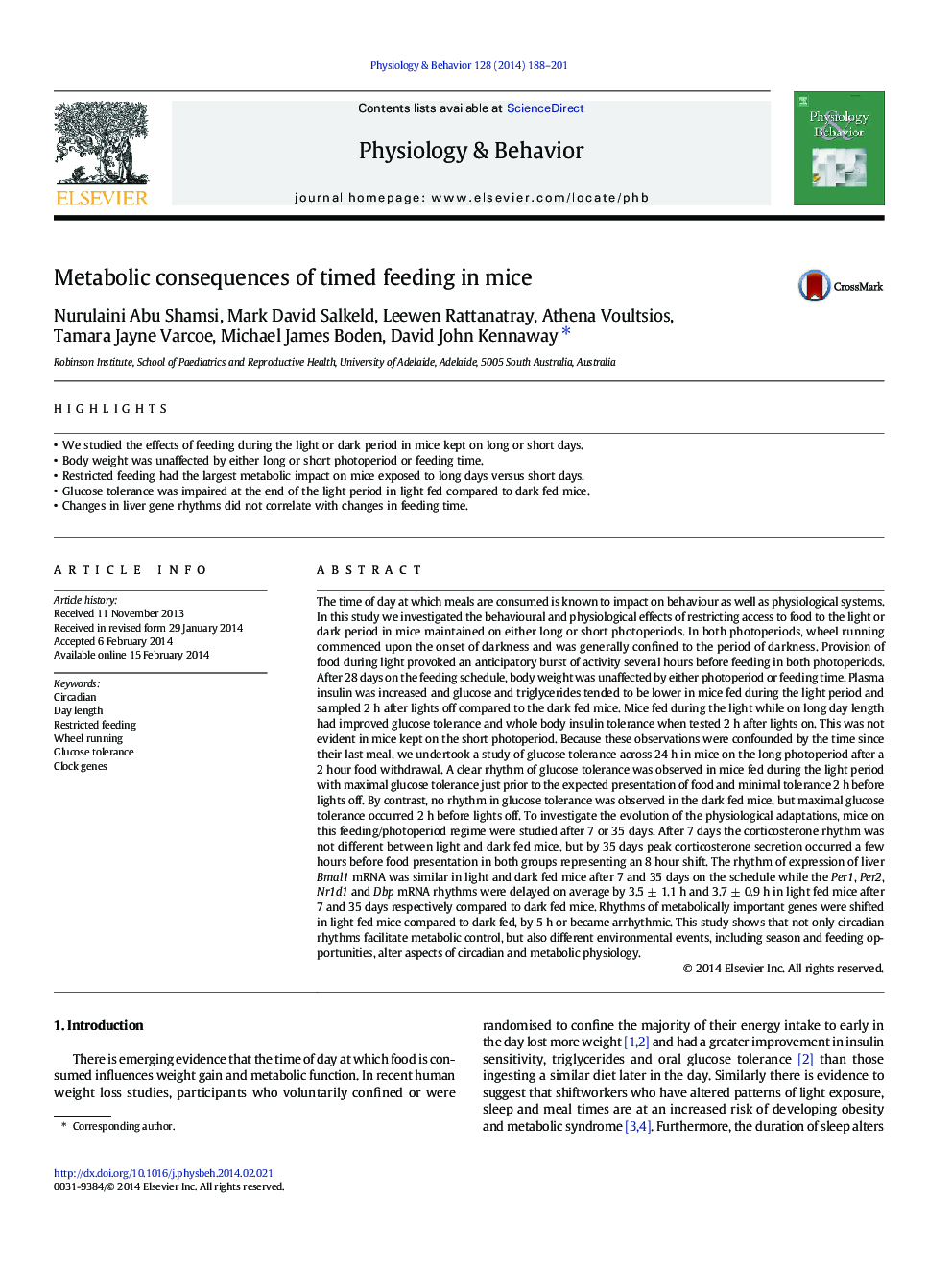| کد مقاله | کد نشریه | سال انتشار | مقاله انگلیسی | نسخه تمام متن |
|---|---|---|---|---|
| 5924464 | 1571189 | 2014 | 14 صفحه PDF | دانلود رایگان |
- We studied the effects of feeding during the light or dark period in mice kept on long or short days.
- Body weight was unaffected by either long or short photoperiod or feeding time.
- Restricted feeding had the largest metabolic impact on mice exposed to long days versus short days.
- Glucose tolerance was impaired at the end of the light period in light fed compared to dark fed mice.
- Changes in liver gene rhythms did not correlate with changes in feeding time.
The time of day at which meals are consumed is known to impact on behaviour as well as physiological systems. In this study we investigated the behavioural and physiological effects of restricting access to food to the light or dark period in mice maintained on either long or short photoperiods. In both photoperiods, wheel running commenced upon the onset of darkness and was generally confined to the period of darkness. Provision of food during light provoked an anticipatory burst of activity several hours before feeding in both photoperiods. After 28 days on the feeding schedule, body weight was unaffected by either photoperiod or feeding time. Plasma insulin was increased and glucose and triglycerides tended to be lower in mice fed during the light period and sampled 2 h after lights off compared to the dark fed mice. Mice fed during the light while on long day length had improved glucose tolerance and whole body insulin tolerance when tested 2 h after lights on. This was not evident in mice kept on the short photoperiod. Because these observations were confounded by the time since their last meal, we undertook a study of glucose tolerance across 24 h in mice on the long photoperiod after a 2 hour food withdrawal. A clear rhythm of glucose tolerance was observed in mice fed during the light period with maximal glucose tolerance just prior to the expected presentation of food and minimal tolerance 2 h before lights off. By contrast, no rhythm in glucose tolerance was observed in the dark fed mice, but maximal glucose tolerance occurred 2 h before lights off. To investigate the evolution of the physiological adaptations, mice on this feeding/photoperiod regime were studied after 7 or 35 days. After 7 days the corticosterone rhythm was not different between light and dark fed mice, but by 35 days peak corticosterone secretion occurred a few hours before food presentation in both groups representing an 8 hour shift. The rhythm of expression of liver Bmal1 mRNA was similar in light and dark fed mice after 7 and 35 days on the schedule while the Per1, Per2, Nr1d1 and Dbp mRNA rhythms were delayed on average by 3.5 ± 1.1 h and 3.7 ± 0.9 h in light fed mice after 7 and 35 days respectively compared to dark fed mice. Rhythms of metabolically important genes were shifted in light fed mice compared to dark fed, by 5 h or became arrhythmic. This study shows that not only circadian rhythms facilitate metabolic control, but also different environmental events, including season and feeding opportunities, alter aspects of circadian and metabolic physiology.
Journal: Physiology & Behavior - Volume 128, 10 April 2014, Pages 188-201
